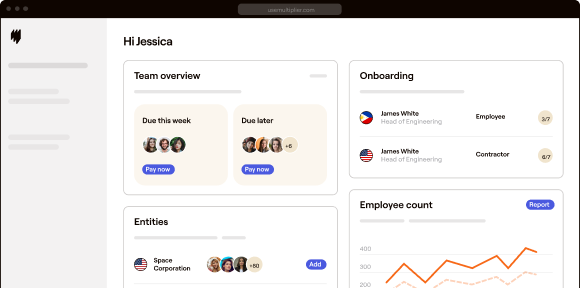Expanding into international markets often acts as a catalyst for business growth, but without the right workforce strategy, it can become a daunting exercise at the same time. A crucial factor to succeed in such a venture is optimizing the talent supply which requires a diversified workforce, encompassing both full-time and part-time employees, service providers, and contingent personnel.
While tenured employees offer long-term value, contingent workers come with flexibility, cost-efficiency, and agility—enabling businesses to scale operations on demand. These workers are especially valuable for narrowing the critical talent gaps during economic uncertainties or staffing shortages.
For businesses expanding globally, contingent workforce solutions present an adaptable approach to meet hiring needs while staying conscious of budget and compliant with specific regulations of a region.
But what exactly are contingent workforce solutions, and why are they so critical? This guide covers every aspect of contingent workforce solutions, offering insights into their features and benefits.
Understanding and implementing contingent workforce solutions
A contingent workforce solution refers to any tool, software, or service that empowers employers in the process of onboarding, management, and payment of contingent workers—including seasonal workers, freelancers, contractors, and consultants. These solutions help organizations manage a flexible workforce at scale, especially as the gig economy is on a growth path.
Here are a few reasons why the importance of contingent workforce solutions is growing.
- Contingent workforce solutions enable companies to adapt swiftly to fluctuating business demands, allowing them to scale their workforce up or down as conditions require.
Businesses utilize contingent workers to fulfil specific roles that require specialized skills not available in-house. They are usually engaged for short-term projects or during peak periods, providing agility and expertise in a fast and efficient manner.
This adaptability is crucial for maintaining competitiveness and responsiveness in a dynamic market environment. This flexible approach to staffing, sometimes described as a ‘hire-and-release’ model, underscores the need for robust contingent workforce solutions. - Managing contingent employees requires a separate share of time and focus.
Organizations need to frame dedicated engagement programs, payment solutions, and insurance policies. And the company’s managers need some extra effort and time to manage freelancers and contractors.
That is where contingent solutions come in handy, helping companies streamline all managerial and payroll duties involving contingent workers, such as generating employment contracts, invoices, and payslips and maintaining them in one place. - Such solutions help prevent employee misclassification by helping lay out a framework for recruiting a contingent workforce and ensuring labor law compliance.
Contingent workers, although beneficial in several ways carry a significant risk of employee misclassification, which varies by country. Businesses need to carefully navigate a complex array of local and international labor laws to ensure proper classification and avoid legal penalties, financial liabilities, and reputational damage. Investing in comprehensive compliance systems is essential for maintaining adherence to diverse regulatory standards. - Hiring and setting up separate HR specialists to manage contingent workers is an expensive undertaking.
Instead, companies can take advantage of modern-day workforce management solutions that can help them pay freelancers and contractors without barriers across the world in no time.
An overview of contingent workforce management solutions
Contingent workers enable businesses to navigate the complex talent landscape with ease. However, managing a contingent workforce seamlessly is easier said than done. There’s so much that goes behind the process, such as screening and selecting the right-fit talent, managing contracts and payrolls, adhering to region-specific labor laws and other compliances, and onboarding contingent workers effectively.
Contingent workforce management solutions solve all of the above challenges by providing a centralized approach to managing all facets of contingent resources. Right from onboarding to project management, they allow firms to leverage the power of flexible and globally-distributed teams while navigating the inherent challenges.
Uncovering the two types of contingent solutions: Contingent workforce software and service providers
Managing a contingent workforce effectively becomes viable with contingent solutions that involve both software and service providers. Let’s discuss them.
Contingent workforce software
These solutions help automate and simplify the contingent management process by streamlining such processes as onboarding, compliance management, employee analytics, and more. Contingent software solutions help manage visibility regarding an organization’s workforce, ensuring that it complies with regulations and manages vendor collaborations effectively.
Contingent workforce service providers
Staffing service providers are companies that enable businesses to manage their contingent workforce by overseeing crucial activities, such as hiring, sourcing, compliance adherence, payroll, and vendor management. These providers also employ technology to deliver extensive contingent staffing solutions tailored per the business needs.
Pros
Contingent workforce software | Contingent workforce service provider |
It’s commonly a component of a vendor management system (VMS) and can be linked with human capital management (HCM) solutions. | Provides companies with necessary support to manage their contingent workforce. |
It effectively streamlines the process of negotiating with vendors and receiving candidates. | Finding best-fit candidates is feasible using these services. |
Onboarding becomes a breeze using these tech solutions. | Onboarding and terminating contractual associations are well streamlined. |
It helps automate the invoicing and payments process. | It efficiently helps with payroll management for the contingent workforce. |
Much like managing new workers, offboarding is quite simple as well. | It helps keep a tab on regulatory compliances for streamlined operations. |
It helps determine the effectiveness of vendors as well who supply the contingent workforce. | It acts as a link between businesses and vendors |
It helps facilitate better collaboration between users and staffing agencies/consulting firms by managing the requisition distribution process effectively. | It helps facilitate better visibility and management of contingent workers, ensuring a reduction in staffing costs and hiring times. |
Cons
Contingent workforce software
| Contingent workforce service providers |
Technical obstacles may crop up while integrating the contingent workforce software with enterprise management systems. | Businesses may feel relatively less control over their contingent labor when relying on service providers. |
It’s essential to learn the features of the new software platform first before using it. | In the event of disagreement between the provider’s perspective and the company’s objective, conflicts may escalate. |
Involves substantial licensing and setup costs. | Excessive dependence on a single service provider may prove risky if the provider reneges on its promise. |
If the system experiences downtime, it may cause an operational hassle. | Critical company information may be accessible to the provider, posing grave confidentiality concerns. |
How to select the right contingent workforce solution
Choosing the right solutions can be difficult, especially with so many options out there. However, businesses can simplify this process by following a systematic approach and considering factors like scalability, integration, and support. Here’s a step-by-step guide:
Step 1: Understand your business needs
Before delving into various solutions, you need a comprehensive view of your business requirements. Take the time to identify the issues you aim to address and the objectives you aspire to accomplish.
Step 2: Define key features
Make a list of the key features that your solution must have. This could include ease of use, compatibility with existing systems, or specific functionalities that are important for your business or industry.
Step 3: Consider scalability
As your business grows, your needs will change. Choose a solution that can scale with your business. It should be able to accommodate more users, handle increased data, and adapt to complex processes as your business expands.
Step 4: Check integration capabilities
To ensure a smooth transition, incorporating your new solution should seamlessly align with your current systems. This will facilitate uninterrupted operations and guarantee a streamlined workflow, optimizing efficiency and productivity.
Step 5: Evaluate support services
Before making a decision, check the kind of support services the solution provider offers. Look for reliable customer support, availability of resources for learning about the system, and how they handle issues and updates.
Step 6: Compare different solutions
After shortlisting a few contingent workforce solutions that meet your criteria, compare them based on their features, pricing, reviews, and overall value. You can also book a demo or trial to get a feel of how the solution works.
Step 7: Make a decision
Based on your comparison, choose the solution that best meets your needs and budget. Remember, the cheapest option may not always be the best. Consider the value and benefits the solution will bring to your business.
Step 8: Implement the solution
Once you have selected a contingent workforce solution, plan for its implementation. This may involve training your staff, migrating data, and setting up the system.
By following these steps, you can ensure that you select the best solution for your business. Remember, the goal is not just finding a solution but the right one to help your business grow and succeed.
Exploring contingent workforce management solutions
Organizations seeking a competitive advantage in today’s complex work environment can use contingent workforce solutions to increase productivity and stay on track with their goals. Listed below is a selection of tools that can assist firms in enhancing operational efficiency and streamlining contingent workforce management:
Deel
Deel is a cloud-based platform to sort out the complexities of global payroll and compliance for businesses seeking to recruit employees and contractors across the globe. Founded in 2019, it offers global coverage, service, and reliable compliance.
Key features:
Deel offers integration with existing payroll systems, simplifying processes like tax filings, deductions, and employee benefits.
- It helps automate processes concerning compliance, local tax, and employment regulations.
- Its convenient dashboard makes onboarding and offboarding for diverse worker types (contractors, remote workers) easy.
- Its self-service portal allows candidates to access their dashboard, which involves employee benefits, payslips, etc.
Remote
Remote’s contingent workforce management system enables businesses to manage and onboard remote teams internationally alongside payroll and compliance solutions.
Key features:
- Its EOR solutions help navigate global HR with ease, enabling businesses to hire exceptional talent globally, and that too without establishing local entities.
- Remote helps streamline payroll in multiple currencies, manage diverse teams, and recruit top talent, all from one intuitive platform.
- Its local plans comprise benefits that are compliant, comprehensive, and flexible — all at competitive rates.
- Remote effectively manages local payroll, taxes, benefits, and compliance to safeguard businesses from any unforeseen obstacles.
Papaya Global
Papaya’s automated platform simplifies payroll, compliance, and workforce management, providing real-time insights and seamless operations for diverse employment types across global teams.
Key features:
- Papaya Global seamlessly integrates a company’s current data and partners, making it easy to manage payroll and payments from one platform.
- It helps pay employees directly to their payroll card, assuring greater security and convenience.
- Its consolidated platform helps hire contractors, track invoices, and manage payments on a single platform.
Velocity Global
Velocity Global is also a notable contingent workforce management system that helps companies compliantly hire, pay, and manage remote workers worldwide via its EOR solutions.
Key features:
- Its solutions help companies onboard global talent and expand to new markets compliantly.
- The tool assists businesses to accurately and compliantly pay their global workforce.
- Its talent-centric considerations help equip businesses with the competitive perks and rewards that keep talent engaged for the long term.
- The tool includes expert support and comprehensive coverage that simplifies the ever-changing immigration process, facilitating team relocations with ease.
Multiplier
Multiplier’s global employment platform enables businesses to simplify and transform complex and time taking HR processes. From global payroll to compliant onboarding, it offers a versatile solution for expanding into new markets, accessing top talent, and ensuring compliance with local regulations.
Key features:
- Employer of Record (EOR): Multiplier’s SaaS-based EOR solution helps businesses quickly build and manage fully remote teams, enabling a 90% faster entry into new markets.
- Global Payroll: Multiplier’s end-to-end payroll management system enables organizations to process payroll in over 100 countries through a unified dashboard. This grants teams complete control over each payment cycle, streamlining global payroll operations for distributed teams of any size.
- Holistic compliance and risk management: Multiplier’s platform helps employers navigate tax compliance, manage essential forms, facilitate smooth onboarding, and stay abreast of labor laws across various nations. It enables organizations to concentrate on strategic planning and expansion, while Multiplier handles operational complexities to ensure seamless and straightforward compliance.
- Localized, comprehensive benefits: Multiplier offers various benefits plans with robust coverage options in 150+ countries, allowing organizations to customize benefits according to the diverse needs of a global workforce.
- Multiplier’s USP: Multiplier’s EOR services and compliance management solutions are designed to help businesses expand globally and access world-class talent. This highly advanced platform offers a seamless experience from onboarding to offboarding, including employee engagement and payroll management, supporting companies in their growth ambitions.
This brief tool analysis underscored the importance of an all-in-one solution that enables businesses across the globe to streamline and revolutionize their contingent workforce management processes.
Best practices for implementing contingent workforce solutions
Here are key practices for successfully implementing contingent workforce solutions:
- Utilize an EOR and global employment platform: The foundation of a successful contingent workforce strategy starts with having a global employment platform in place. An EOR simplifies hiring, payroll, and compliance by consolidating these processes into a single system. This allows companies to hire contingent workers across regions swiftly and legally, without needing to establish a legal entity in every country.
- Foster cross-departmental alignment: Implementing a contingent workforce solution shouldn’t happen in silos. It’s important for all relevant departments such as HR, procurement, and department managers to be aligned. A holistic approach ensures that the system integrates seamlessly with other business operations, offering full visibility over spending, resource allocation, and hiring processes across the organization.
- Stay informed on management trends: Staying up to date on the latest trends and practices, particularly in onboarding and engaging contingent workers, is essential. As contingent roles become more mainstream, businesses need to adapt to shifts in perception and ensure their strategies reflect current best practices in workforce management.
- Centralize processes for efficiency: Many organizations, especially those with limited contingent workforce spending, struggle with fragmented processes. By centralizing contingent workforce management, companies can streamline operations, reduce inefficiencies, and unlock the full potential of a flexible, non-permanent workforce.
Case study: How Mindvalley successfully implemented contingent workforce management solutions from Multiplier
The client
Mindvalley is a titan in the ed-tech space, headquartered in Kuala Lumpur, Malaysia, with a diverse team of over 250 talented professionals.
The challenge
Mindvalley’s ambitious international growth expansion strategy involved recruiting from a global talent pool. Their initial efforts to open local entities to procure the best talent were strenuous and expensive undertakings. That is when they sought a single EOR provider that could manage their infrastructure and help them conduct hiring at their desired locations.
The solution
Multiplier stakeholders anticipated needing a centralized solution to handle their global hiring needs. They discovered the ideal, holistic solution in Multiplier—a SaaS-based Employer of Record (EOR) platform. The platform helped them streamline the onboarding and management of their contingent workforce.
The impact
Multiplier’s fully-owned infrastructure, quick turnaround time, and competitive pricing met the client’s criteria. Its robust, all-encompassing platform for hiring, insurance, and payroll and top-notch customer success teams enhanced their overall experience.
With Multiplier, senior leaders at Mindvalley easily forecasted hiring costs, planned hiring budgets accordingly, and implemented the best practices when hiring internationally. Most importantly, they hired 18 employees across Europe and Asia in record time via the platform.
Managing contingent workforces with Multiplier
Multiplier’s global workforce management platform enables businesses all over the world to streamline and revolutionize their HR processes. From global payroll to quick and compliant onboarding, we can help your business grow into new markets and discover the best talent.
So, are you ready to transform your global hiring process? Talk to our experts to discover innovative global workforce management solutions.
FAQs
Q. How does contingent workforce management software work?
Contingent workforce management software unifies the recruitment and management of contingent employees in a web-based platform, automating and centralizing processes like addressing talent inquiries, reviewing the proposals, integrating new hires into the system, evaluating timesheets and costs, and terminating the contracts, enabling organizations to manage the entire employee lifecycle in one place.
Q. What is the difference between a contingent worker and a permanent employee?
Contingent workers are non-permanent employees, including temporary resources, seasonal workers, freelancers, contractors, and consultants, hired on a project basis for a specific period. Permanent employees hold long-term positions within an organization. They enjoy better job stability, receive a fixed salary, and various other benefits.
Q. What are the challenges of managing contingent workers?
The main challenges inherent in contingent workforce management include compliance challenges, onboarding hassles, quality concerns, and performance tracking across projects.







